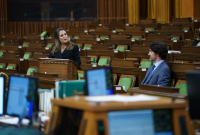Support strong Canadian climate journalism for 2025
While the Liberal-NDP agreement between the parties expires in June 2025, most items on their priority list have already been completed and what’s remaining could be done by June 2023. Another election might be imminent after the March 28 federal budget.
As many have argued, Liberal-NDP minority governments can be tremendously productive. The Pearson government in the 1960s collaborated with the NDP to bring in medicare and the Canada Pension Plan, for instance.
The current Liberal-NDP agreement also resulted in new major programs, such as the beginning of a dental care program. The new $10-a-day national child-care program was also created during the minority government, although before the explicit agreement.
The Liberals have also delivered on a new tax on big banks, new affordable housing funding, a sustainable jobs plan for workers in a cleaner economy, and cash support for low-income renters — all items in the agreement.
And let’s not forget about the federal government’s pandemic response: it led the way in income supports for individuals, families and businesses, which staved off a major economic collapse and resulted in a decrease in poverty in 2020.
This month’s budget could spell the end of such big-picture thinking.
There will be reannouncements of already promised items, such as the 10-year federal-provincial health-care funding deal. The question moving forward, of course, is whether the provinces will actually spend that money on health care, given there are so few strings attached to that funding.
Already, several provinces have rolled out new tax cuts, effectively transforming health-care dollars into lower taxes for the rich. Manitoba is a case in point.
We might see more details on the dental care plan and its expansion.
The government has also signalled that it intends to respond to the U.S. Inflation Reduction Act, which passed last summer and included a raft of subsidies and incentives for renewable energy and other clean tech.
Although we are almost certain to see new green spending in the budget, it’s not clear whether the government will seek to compete directly with the U.S. by offering matching tax breaks or whether it will adopt a more targeted industrial policy approach. For example, the budget could include direct spending in strategic areas, such as electricity transmission and battery production.
We’re likely to see another revenue “surprise,” with higher-than-expected corporate income tax revenues due to booming corporate profits in 2022. Rising corporate profits certainly have helped most of the provinces balance their budgets, but it won’t be enough to eliminate the federal deficit right away.
In the likely-but-not-certain category, there could be measures to help lower-income households afford higher prices, such as a continued top-up to the GST credit, which is set to expire in June.
While child-care fees are dropping, the problem now is to create new spaces so that more Canadian families can benefit from the $10-a-day program, so that might make it into the budget.
Now for the things that probably won’t be in this year’s budget.
The pandemic taught us plenty of lessons, particularly around how well the Canada Emergency Response Benefit functioned compared to Canada’s broken Employment Insurance (EI) system.
It turns out that we can, in fact, provide easy and rapid access to flat-rate benefits for all workers, including self-employed workers. Unfortunately, the federal government has since cut those income supports, leaving us with a battered EI program that’s not up to the job. The federal government could introduce key EI reforms following last year’s review of the program, but probably won’t.
And despite new green spending, we are unlikely to see new investments in climate action on the scale needed to rapidly decarbonize the Canadian economy while creating good, green jobs for workers across the country.
The pandemic also highlighted the brutal state of long-term care in Canada. Parliament is considering legislation to create national standards of care — a plank in the Liberal-NDP agreement. There is $3 billion over 10 years already in the fiscal framework, with another $1.7 billion to support higher wages for personal support workers in the February 2023 health-care announcement — much of which will end up in long-term care.
Pharmacare probably isn’t going to happen in this budget, although the Liberals are checking the boxes in their NDP agreement that might eventually get us there.
The Canada Disability Benefit, despite being in the Liberal mandate letter, likely won’t be any closer to reality, either.
Finally, there likely won’t be additional corporate tax increases, like the excess tax on big banks last year, even though oil and gas would be a prime target given the sector is a major driver of inflation.
David Macdonald is a senior economist and Hadrian Mertins-Kirkwood is a senior researcher, both of whom are with the Canadian Centre for Policy Alternatives.







Comments